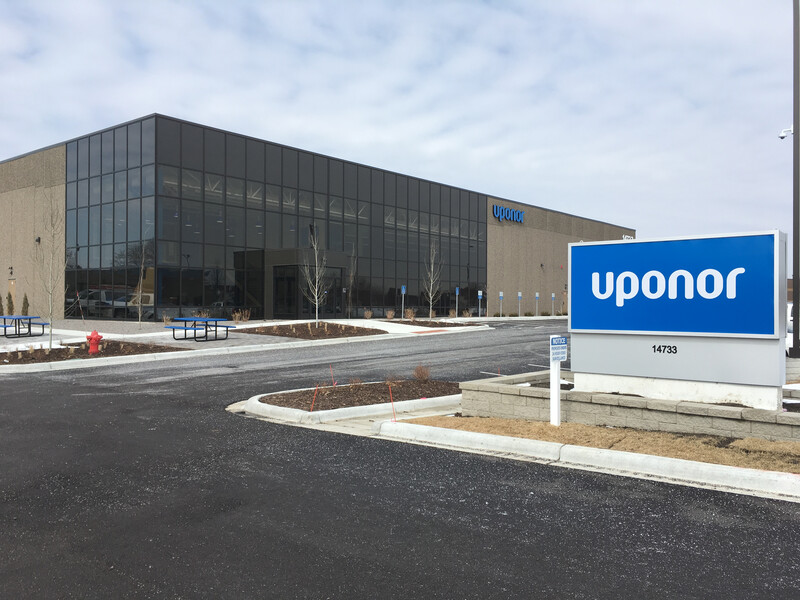Plastic pipe withstands mill’s process water,
Imatra,
Finland
Plastic pipe withstands mill’s process water
Stora Enso’s Imatra mill, located in southeast Finland, annually produces one million tonnes of packaging paper and board. The Imatra mill’s two production units produce raw materials for cartons, in which juice and milk are packaged. Board is also used to produce paper cups, as well as cigarette and candy packages. Board for the graphics industry is used to produce cards, covers and luxury packages.
The process water required in the manufacture of board and paper has thus far run through concrete channels to the treatment process facility, after which the water has been discharged into Lake Saimaa. The hot water that contains chemicals has worn down and eroded the concrete structures so much that a new solution had to be found for transporting the process water.
The project was assigned to Efora, an enterprise jointly owned by Stora Enso and ABB. The company specialises in providing the industry with maintenance and other services that secure smooth running and uninterrupted operations at mills.
Three options
According to project manager Pasi Tiilikainen, there were three options for replacing the former concrete channels. “We considered coating the concrete channels with four to six millimetre thick stainless steel. We could also have used GRP piping, but after we conducted calculations, we settled on Weholite pipes manufactured from polypropylene.”Polypropylene pipes have also previously been installed at Stora Enso’s mills, and, to date, the experiences gained have been positive.
The use of stainless steel would have been the most expensive of these options. According to Mr Tiilikainen, the two different plastic pipe options were in the same price range, but the timetables offered tipped the scale in Uponor Infra´s favour.
“Time is the key factor that made the difference. The best solution for Stora Enso was the one that caused the shortest possible interruption in the mill’,” Mr Tiilikainen states.
Installation of the Weholite pipe caused practically no interruption in operations, as the installation was completed during the mill’s annual week-long maintenance stoppage in September.
“Our third criterion in this selection process was related to work methods. A clear advantage of the Weholite pipe was that it could be slid into the already existing concrete channel, whereas this was not possible with the GRP pipe. Instead, the concrete channel would have had to be opened for installation of the GRP pipe to be possible.”
Work spread out over two years
As Stora Enso is dividing the project costs over the course of two years, the project will be completed in two stages. However, the greater reason for this is the mill’s timetable: operations are interrupted least when installation work is carried out during the mill’s annual maintenance stoppage.
The first stage of the project was completed in a timeframe of just over two weeks.
“The first week was spent carrying out preparation work, and installation work was completed the second week,” Mr Tiilikainen explains.
During the first stage, seventy metres of pipe, with a diameter of 1.6 metres, was installed at the mill. The pipe was slid into the existing concrete channel. Additionally, two segment bends were installed in preparation for the project’s second stage.
At that time, a further 120 metres of pipe will be added to the system and buried underground. As the pipeline will curve back and forth, completion of the installation work will require the addition of five or six segment bends. Dite manager Kimmo Sjöman oversaw the preparation and installation work during the first stage of the project at Imatra.
“We had two men working on preparation work during the first week and four men completing installation the second week. Additionally we had two excavators, a front loader and a lorry with a winch on hand for the installation work,” Mr Sjöman recounts.
PP pipe withstands high temperatures
Weholite pipe is manufactured by spiral welding PE or PP profiles. Polypropylene pipe is suited for use in instances where the pipe must withstand high temperatures.
Anders Andtbacka, product manager for Uponor Infra, says that PP pipe can withstand temperatures of up to 80°C. The temperature of process water at the Imatra mill rises at most to 60°C.
“Polyethylene and polypropylene pipes are of equal standing with regard to their mechanical characteristics and resistance to the effects of chemicals,” Mr Andtbacka explains.
Polypropylene pipe is slightly stiffer than polyethylene pipe. This is an advantage in some situations and a disadvantage in others. And this was the case at Imatra: “We specifically wanted a stiff pipe at the Imatra site, because, at points, the piping runs close to the earth’s surface and is therefore subject to traffic load,” Mr Andtbacka says.
According to Mr Sjöman, sliding the stiff pipe into a square tunnel was somewhat difficult, as there was little space and the pipe did not bend easily. The outside diameter of the pipe was 1.8 metres. The pipe was slid into a square tunnel that was 2 x 2 metres in size.
According to Mr Sjöman, the hole into which the pipe was fitted had to be made a bit larger than originally planned, but otherwise the work progressed as intended.
“It was a tight fit, but we were successful,” Mr Sjöman recounted. During the slip lining procedure, a wire was attached to one end of the pipe, which made it possible to pull the pipe into the tunnel.
Excavators then pushed the piping into the concrete channel. According to Mr Sjöman and Mr Tiilikainen, the installation was completed successfully and within the agreed timeframe. However, there were small setbacks during commissioning, when a small leak was observed in an inspection chamber. The cause of this leak was fixed by sealing up the welding seams. Everything was ready for the project’s second sta
